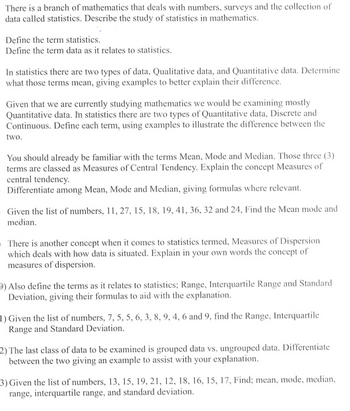
MATLAB: An Introduction with Applications
6th Edition
ISBN: 9781119256830
Author: Amos Gilat
Publisher: John Wiley & Sons Inc
expand_more
expand_more
format_list_bulleted
Question

Transcribed Image Text:There is a branch of mathematics that deals with numbers, surveys and the collection of
data called statistics. Describe the study of statistics in mathematics.
Define the term statistics.
Define the term data as it relates to statistics.
In statistics there are two types of data, Qualitative data, and Quantitative data. Determine
what those terms mean, giving examples to better explain their difference.
Given that we are currently studying mathematics we would be examining mostly
Quantitative data. In statistics there are two types of Quantitative data, Discrete and
Continuous. Define each term, using examples to illustrate the difference between the
two.
You should already be familiar with the terms Mean, Mode and Median. Those three (3)
terms are classed as Measures of Central Tendency. Explain the concept Measures of
central tendency.
Differentiate among Mean, Mode and Median, giving formulas where relevant.
Given the list of numbers, 11, 27, 15, 18, 19, 41, 36, 32 and 24, Find the Mean mode and
median.
There is another concept when it comes to statistics termed, Measures of Dispersion
which deals with how data is situated. Explain in your own words the concept of
measures of dispersion.
) Also define the terms as it relates to statistics; Range, Interquartile Range and Standard
Deviation, giving their formulas to aid with the explanation.
1) Given the list of numbers, 7, 5, 5, 6, 3, 8, 9, 4, 6 and 9, find the Range, Interquartile
Range and Standard Deviation.
2) The last class of data to be examined is grouped data vs. ungrouped data. Differentiate
between the two giving an example to assist with your explanation.
3) Given the list of numbers, 13, 15, 19, 21, 12, 18, 16, 15, 17, Find; mean, mode, median,
range, interquartile range, and standard deviation.
Expert Solution
This question has been solved!
Explore an expertly crafted, step-by-step solution for a thorough understanding of key concepts.
This is a popular solution
Trending nowThis is a popular solution!
Step by stepSolved in 3 steps

Knowledge Booster
Similar questions
- Which of the following would be the least helpful type of data to a car manufacturer when making business decisions? Employment data Competitor data Economic data School attendance data Financial dataarrow_forwardAnswer this question in R. Show as much of your work as possible.arrow_forwardPart b and c please?arrow_forward
- Please show me how this is worked outarrow_forwardWhat is the purpose of a Data Dashboard? If you were the manager of a restaurant, for example, what 5 key metrics would you want to display on a Data Dashboard?arrow_forwardAn understanding of statistics is necessary in any job. The use of statistics can help provide answers to many questions. Please, post a question you think that statistics may help you answer and explain why statistics can help provide an accurate answer. Read several of your classmates' postings. Do you agree that statistics are necessary to answer their questions? Is their question one that you would also like to have an answer to? Why or why not?arrow_forward
- Please check answers 1; 0.351 2; 0.060 3;0.205 4; 0.172arrow_forwardThe Methods section of a research paper is where the researchers describe the statistical analyses that they employed. True Falsearrow_forwardCan you find a set of data such that the mean, median, and variance are all equal to each other? Find as many data sets as possible. If none are possible, explain why. If many are possible explain why. If you find any patterns explain what they are and how they are useful in the hunt for understanding this question.arrow_forward
- Please please answer fast please answer as fast as possible please it's super important and super urgentarrow_forwardfind an example of when statistics were misused/skewed and state the reason why you think the statistics were reported that way.arrow_forwardIn a recent article you see a histogram graph that displayed the average number of hours teens get in a night. The graph is a form of what type of statistics? Descriptive or Inferentialarrow_forward
arrow_back_ios
SEE MORE QUESTIONS
arrow_forward_ios
Recommended textbooks for you
 MATLAB: An Introduction with ApplicationsStatisticsISBN:9781119256830Author:Amos GilatPublisher:John Wiley & Sons Inc
MATLAB: An Introduction with ApplicationsStatisticsISBN:9781119256830Author:Amos GilatPublisher:John Wiley & Sons Inc Probability and Statistics for Engineering and th...StatisticsISBN:9781305251809Author:Jay L. DevorePublisher:Cengage Learning
Probability and Statistics for Engineering and th...StatisticsISBN:9781305251809Author:Jay L. DevorePublisher:Cengage Learning Statistics for The Behavioral Sciences (MindTap C...StatisticsISBN:9781305504912Author:Frederick J Gravetter, Larry B. WallnauPublisher:Cengage Learning
Statistics for The Behavioral Sciences (MindTap C...StatisticsISBN:9781305504912Author:Frederick J Gravetter, Larry B. WallnauPublisher:Cengage Learning Elementary Statistics: Picturing the World (7th E...StatisticsISBN:9780134683416Author:Ron Larson, Betsy FarberPublisher:PEARSON
Elementary Statistics: Picturing the World (7th E...StatisticsISBN:9780134683416Author:Ron Larson, Betsy FarberPublisher:PEARSON The Basic Practice of StatisticsStatisticsISBN:9781319042578Author:David S. Moore, William I. Notz, Michael A. FlignerPublisher:W. H. Freeman
The Basic Practice of StatisticsStatisticsISBN:9781319042578Author:David S. Moore, William I. Notz, Michael A. FlignerPublisher:W. H. Freeman Introduction to the Practice of StatisticsStatisticsISBN:9781319013387Author:David S. Moore, George P. McCabe, Bruce A. CraigPublisher:W. H. Freeman
Introduction to the Practice of StatisticsStatisticsISBN:9781319013387Author:David S. Moore, George P. McCabe, Bruce A. CraigPublisher:W. H. Freeman

MATLAB: An Introduction with Applications
Statistics
ISBN:9781119256830
Author:Amos Gilat
Publisher:John Wiley & Sons Inc

Probability and Statistics for Engineering and th...
Statistics
ISBN:9781305251809
Author:Jay L. Devore
Publisher:Cengage Learning

Statistics for The Behavioral Sciences (MindTap C...
Statistics
ISBN:9781305504912
Author:Frederick J Gravetter, Larry B. Wallnau
Publisher:Cengage Learning

Elementary Statistics: Picturing the World (7th E...
Statistics
ISBN:9780134683416
Author:Ron Larson, Betsy Farber
Publisher:PEARSON

The Basic Practice of Statistics
Statistics
ISBN:9781319042578
Author:David S. Moore, William I. Notz, Michael A. Fligner
Publisher:W. H. Freeman

Introduction to the Practice of Statistics
Statistics
ISBN:9781319013387
Author:David S. Moore, George P. McCabe, Bruce A. Craig
Publisher:W. H. Freeman